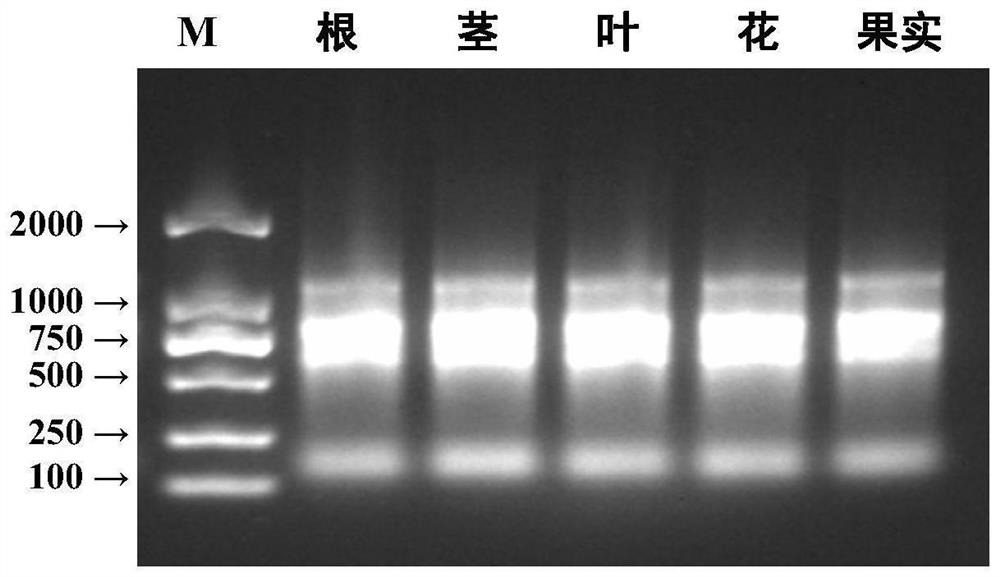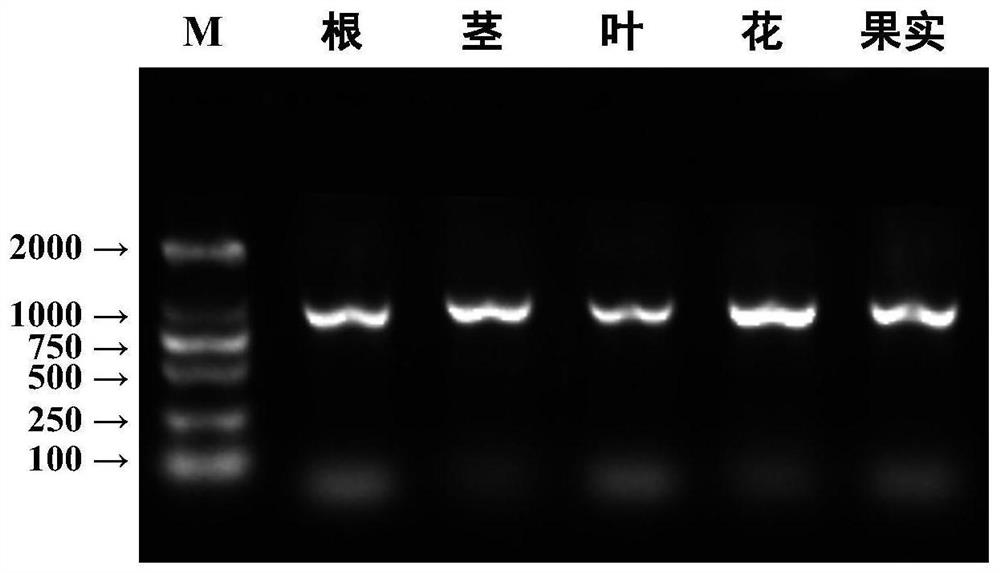Method for extracting total RNA (Ribonucleic Acid) from rose plant tissues
A technology of plant tissue and Rosa, which is applied in the field of extracting high-quality total RNA, can solve the problems of unsatisfactory, low broad-spectrum, poor integrity of total RNA, etc., and achieve the effect of improving quality and yield
- Summary
- Abstract
- Description
- Claims
- Application Information
AI Technical Summary
Problems solved by technology
Method used
Image
Examples
Embodiment 1
[0062] Embodiment 1, the method that extracts total RNA from Rosa plant tissue
[0063] In this example, total RNA was extracted from the tissues (roots, stems, leaves, flowers and fruits) of wild rose, Chinese rose ('Yueyuefen' variety), rose ('Zizhi' variety), and various tissues (roots, stems, leaves, flowers and fruits), including The following steps:
[0064] (1) Weigh 0.2g of roots, stems, leaves, flowers and fruits, respectively, into a mortar pre-cooled by liquid nitrogen, add 0.01g of PVPP (crospovidone, cross-linked polyvinylpyrrolidone), and place in liquid nitrogen fully ground into fine powder;
[0065] (2) Quickly transfer the sample powder (fine powder) to a 1.5 mL RNase-free centrifuge tube (RNase-free centrifuge tube) containing 0.6 mL of solution A, vortex to mix, let stand for 3 minutes, and centrifuge at 12,000 rpm for 5 minutes;
[0066] (3) Aspirate the supernatant into a new 1.5mL RNase-free centrifuge tube, add an equal volume of solution B, shake and...
Embodiment 2
[0091] Example 2: Detection of cDNA quality by reverse transcription synthesis of total RNA from different tissues of Rhododendron chinensis
[0092] 1. Take the total RNA of the roots, stems, leaves, flowers and fruits of Rosa japonica obtained in Example 1 as a template, and utilize Novizan Biotechnology Co., Ltd. II Reverse Transcriptase Reverse Transcription Kit performs reverse transcription (RT) to synthesize the root cDNA, stem cDNA, leaf cDNA, flower cDNA and fruit cDNA respectively, and store at -20°C for later use.
[0093] 2. Detect and analyze the cDNA of each tissue of Rose thorn in step 1 by 1% agarose gel electrophoresis. Electrophoresis imaging results ( figure 2 ) shows that the cDNA bands are mainly distributed between 0.5 and 1.0 kb, with a wide distribution range and high concentration, indicating that the cDNA synthesized by reverse transcription of total RNA from different tissues of Rhizoma thorne extracted by the method of the present invention is of...
Embodiment 3
[0094] Example 3: Amplification of Rose RcACTIN Gene Fragment by RT-PCR
[0095] 1. The total RNA of Chinese rose root, stem, leaf, flower and fruit obtained in Example 1 is used as a template, using Novozyme Biotechnology Co., Ltd. II Reverse Transcriptase Reverse Transcription Kit performs reverse transcription (RT) to synthesize cDNA of rose root, stem, leaf, flower and fruit respectively, and store at -20°C for future use.
[0096] 2. Using the cDNA of each rose tissue obtained in step 1 as a template, RcACTIN-F (5'-TGGGACTGGAATGGTCAA-3') and RcACTIN-R (5'-GATGCTAAGATAGAGCCTCCG-3') as primers to carry out polymerase chain reaction ( PCR) to amplify the fragment of the rose RcACTIN gene (RcHm_v2.0_Chr3g0466761).
[0097] PCR reaction system: 25 μL 2×Taq PCR master mix, 5 μL cDNA template, 10 μL 1 μM F primer and 10 μL 1 μM R primer.
[0098] PCR reaction program: pre-denaturation at 94°C for 5min, denaturation at 94°C for 30sec, annealing at 58°C for 30sec, extension at ...
PUM
 Login to View More
Login to View More Abstract
Description
Claims
Application Information
 Login to View More
Login to View More - R&D
- Intellectual Property
- Life Sciences
- Materials
- Tech Scout
- Unparalleled Data Quality
- Higher Quality Content
- 60% Fewer Hallucinations
Browse by: Latest US Patents, China's latest patents, Technical Efficacy Thesaurus, Application Domain, Technology Topic, Popular Technical Reports.
© 2025 PatSnap. All rights reserved.Legal|Privacy policy|Modern Slavery Act Transparency Statement|Sitemap|About US| Contact US: help@patsnap.com



